
Content Marketing Case Study: How To Get 100K Website Visitors per Month
In 1996, Bill Gates wrote an essay titled “Content is King”. Today’s digital marketers are constantly repeating the phrase “content is king,” but Gates anticipated the potential success of content marketing over 20 years ago. He wrote that “broad opportunities for most companies involve supplying information or entertainment. No company is too small,” and he was right.
If your website lacks the traffic you want, content may very well be the answer. Our client website, Social Buddy, which markets an Instagram growth service, had very little traffic six months ago. It is now on track to surpass 100,000 visitors a month. All we had to do was consistently publish relevant, keyword researched, well-written, SEO optimized content.
Organic Traffic Increased Over 1745% in 6 Months Through Content
When I began writing content for Social Buddy at the end of December 2018, the website had peaked at about 5,000 organic visits per month. For the last few months, it had lingered around 3,000 on average. There was some blog content, but it wasn’t based on research and wasn’t focused.
My strategy began with in-depth keyword research to develop a plan on what to post and when. I began regularly publishing content to the blog – articles that related to Instagram like how to’s, tips, and other social media related informational posts – and traffic took off.

Five months later, posting consistent, quality content, we hit over 100,000 visitors per month. The only thing we did differently was publish smart, research-based content, and in only 5 months organic search traffic increased more than tenfold.
How? Through content marketing and search engine optimized content.
Content Marketing 101
Content is any form of media that shares information and (hopefully) drives traffic to your site. Content can come in the form of blog posts, images, videos, infographics, quizzes, and more. It’s really any type of informative media that you post to your site for the purpose of sharing information, not selling products or services.
Good content will not only bring visitors to your website, but keep them there. This increases the chance of them visiting other pages or eventually converting into customers. You can see below the increase in average time spent on Social Buddy pages as we improved content.
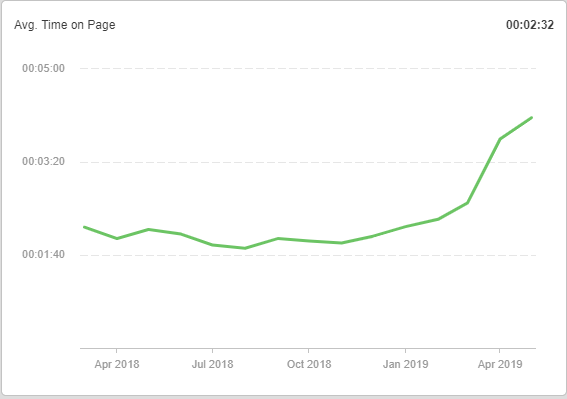
Content marketing does, eventually, work towards customer conversion and sales, but it’s not the same as the ad copy on the sales pages of a website. Content aims to provide pertinent information that is relevant to your brand, answering questions that potential customers may have about your industry.
There’s a big difference between publishing any content and publishing smart, SEO content. If you don’t do the necessary keyword research and optimize your content for search engines, it won’t bring in any traffic. Good content takes time and effort.
When done correctly, content drives traffic, improves SEO by helping your website rank for relevant keywords, leads potential customers to your website, and keeps your website fresh with consistent updates and new pages.
How We Used Content to Grow Social Buddy Traffic to 100,000 Visitors per Month
Our strategy that led to success on Social Buddy was simple: we published well-written, informative content that answered questions and searches asked by our target audience. We used our knowledge of SEO tactics and extensive keyword research to create great content and it got results. Here’s how we did it:
Our SEO Content Strategy
-
- Finding Relevant Topics
- Keyword Research
- Writing Long-Form Content
- Linking and Creating Structured Silos
- Tracking and Auditing Your Content
1. Finding Relevant Topics
Before you can publish any content, you need to plan what to write about. There are many ways to find relevant topics, but what makes a topic relevant and worth posting on your website?
When you’re searching for relevant topics, consider these questions:
- Is this topic relevant to my brand or our products and services?
- Are people searching for information on this topic? What questions are they asking?
- Can we write a post that answers their question in a helpful and informative way?
- Who is asking these questions? What audience does this topic attract? Does it match our target audience? Will this topic attract potential customers?
- Can this post lead to conversions? What is the searcher’s intent?
Let’s look at these answers in regard to Social Buddy.
Social Buddy is an Instagram growth service. The target audience is Instagram users, particularly users who want to grow their following. That demographic is probably younger and more social media savvy than every single person with an Instagram account.
Relevant topics for Social Buddy are abundant: anything relating to Instagram and social media is on the table. There are many questions about Instagram or related topics with huge search volumes, so the potential for traffic is enormous.
An easy way to find relevant topics to write about is searching for your main keyword and looking at the “People also ask” box on Google. This shows you what other people are searching and can give you ideas on what to write about.
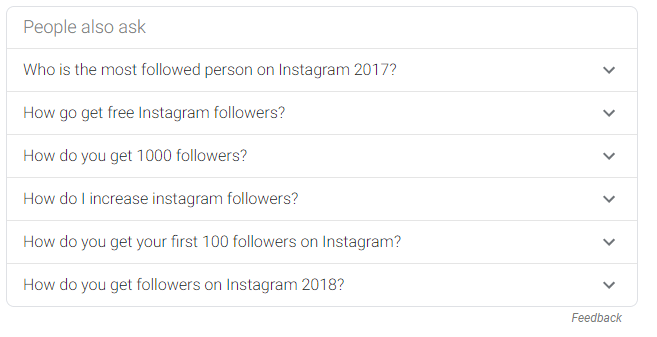
When you consider “Who is asking these questions?” it’s easy to assume that most of them are on Instagram, especially when the topics are directly related to Instagram and how to use it. We did publish other topics that are less focused and more about social media in general, but those don’t stray too far from our target.
Ask these questions for your own website, brand, and business before you begin writing content.
Content That Converts vs. Content That Won’t
When you consider “Will this topic attract potential customers?” and “Can this post lead to conversions?” things get trickier.
A lot of the content on Social Buddy, and even the content that is driving the majority of the traffic, is not necessarily conversion optimized content. Some of the top posts include simple questions people have about Instagram, like how often or when to post.
Many of the top performing pages are hashtag articles, sharing useful hashtags by industry to tag your photos. These site visitors could convert, but many are probably just interested in finding their answer or hashtags and going on their way.
Regardless, this content is useful. Don’t shy away from content that is purely informational that won’t necessarily convince visitors to buy your products or services.
The reason that this content is still great for our website?
- These posts drive traffic. Traffic is essentially proof to Google that your content is good, visitors are engaged, and that the website shares relevant information regarding social media and Instagram. This will only help Social Buddy in the future, as Google will recognize its authority on Instagram and social media-related topics and continue to rank its pages.
- Even if visitors don’t convert, they may return. If they found useful information on Social Buddy before, they may return next time they have a question about a similar topic. And eventually, they may click through to the sales page and buy Social Buddy’s services.
- Visitors can be retargeted. If a visitor to your site provided information like a name or email address, or if your site has cookies or a Facebook retargeting pixel, you can retarget your services to them through email or advertisements.
Consider The Intent of the Search
Intent is important when it comes to content. What is the intent of the person searching? This is important because you want to provide the information they’re looking for to keep them on your page, but some intent is more valuable than others. You can look at this in terms of the sales funnel.
Top of the funnel: Searches like “how to block someone on Instagram” have pretty clear intent, and these visitors very likely won’t convert. They are potential customers, however, since they have an Instagram account, but they may or may not care about followers.
Middle of the funnel: Searches like “how to get verified on Instagram” have a better chance of conversion. If the searcher wants to get verified, they probably want more followers, and therefore may be interested in working with an Instagram growth service. They haven’t reached the point of looking for an Instagram growth service yet, but they are on that path.
Bottom of the funnel: Searches like “how to get more Instagram followers” are much more likely to convert, as these searchers are already looking for followers. They may not be willing to pay to grow their followers, but if we optimize the content for conversion, we’ll be able to convert some percentage of those visitors.
Search intent is a valuable consideration. You should optimize content for search intent on every post. Regardless of where it falls in the sales funnel, your goal is to write helpful, informative content. Conversion optimization is another beast to tackle, but to get traffic to your site you should aim to provide well-written, useful content that is relevant to your brand.
2. Keyword Research
Keyword research is vital to writing content that will rank well on Google and bring traffic to your website. Your content should be optimized with highly searched, topical keywords.
If you want to write about and rank for a certain topic, you need to do the keyword research first. This research will tell you what people are searching in relation to that topic, what questions they’re asking, and what you should include in your post to catch their attention. Keyword research will tell you what to write about, what to title your post, what headers to include, and more.
The general idea is to use the keywords that are most frequently searched for your chosen topic, and place those keywords in the right places within your post. Highly searched, relevant keywords and phrases should always be used in these places:
- Title
- Headers
- URLs
- Meta descriptions
- Image titles and alt text
- Throughout your post
While you should use the best possible keywords, you shouldn’t force awkward headers or titles just because that keyword is the most frequently searched term. One example of a post from Social Buddy is titled “What Happens When You Report an Instagram Account?” This title isn’t the highest searched keyword for this topic.
If I made the title the keyword with the largest search volume, it would be “Report Instagram Account”. This title wouldn’t make sense and wouldn’t convey what the content of the post is actually about.
We opted for a lower search volume keyword, and Google rewarded our quality content – Social Buddy on page 1 in the search results for “Report Instagram Account” and has the featured snippet for a few variations of “what happens when you report an Instagram account”. Google rewards quality.
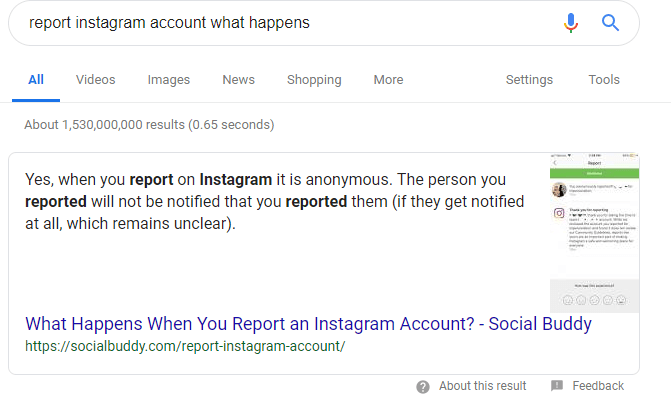
Keyword research can also help you find relevant topics. While doing in-depth research on searches related to Instagram followers, I found hundreds of keywords with questions that I could answer, many in their own posts. This brings us to the topic of long-tail variations of keywords.
Long-Tail Variations Drive Traffic Too
If you find a relevant topic with a huge search volume, you’ll probably want to write a post about it – and you should! Keywords and topics with huge potential for traffic are also competitive, however, and it isn’t always easy to rank for those topics.
You could write a great, SEO optimized, long-form post about a keyword with over 100,000 searches per month, but you still might not unseat competitors. There are over 500 ranking factors that Google considers, and even if your content is better than others, you may not outrank them if they have better authority, traffic, off-page SEO – the list goes on and on.
That’s why most SEO experts will tell you to aim for the low hanging fruit first. In doing so, you can build up traffic and website authority to eventually tackle those bigger keywords, and you may find some gems along the way.
Let’s look back at Social Buddy again.
The highest trafficked post right now is titled “The Order of Instagram Followers and Likes Explained.” Surprised? So were we.
I found this topic while doing keyword research – when I was looking for search terms related to Instagram followers, there were a few asking this question. None had a very high search volume, but I thought it was an interesting topic and something that I myself would Google, so I decided to write a post about it anyway. You can see the keywords and search volumes below.

In the three months that this post has been published on Social Buddy, it has brought over 35,000 page views. That’s about 12,000 a month, way higher than the search volumes suggested.
So how did this happen? We went after some low hanging fruit, long-tail variations.
People seem to be interested in this topic, but there are a few ways to ask the same question. By using these low search volume keywords and writing an informative post, this post is the first search result and often the featured snippet for a few different search terms. By casting a wide net and catching all of these smaller keywords and search queries, a post that none of us expected to matter much is responsible for a huge amount of traffic.
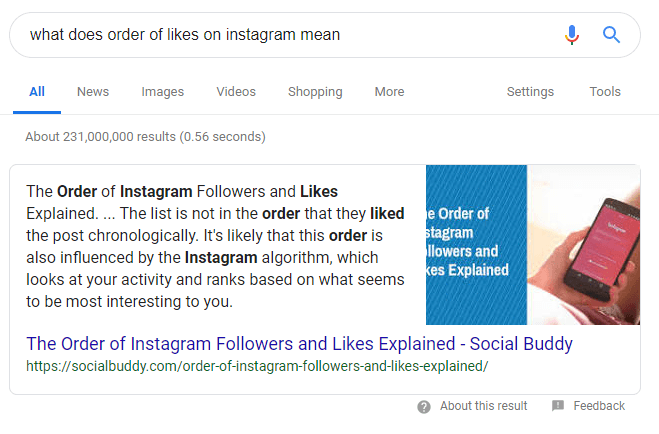
How To Find Keywords
There are various keyword tools that you can use to find keywords and search volumes. Tools that I’ve used include SEMRush, Ahrefs, and Keywords Everywhere.
It’s also helpful to simply search for your main keyword on Google and check out the “People also ask” or “Searches related to” boxes – these provide other keywords and search queries, and often make great headers within your post or can inspire a whole new topic.
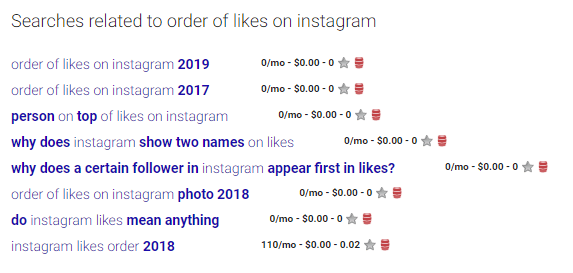
SEMRush and Ahrefs are comprehensive, but expensive, tools that digital marketers use to analyze websites. I use these tools to check out what keywords competitor sites are ranking for and figure out what keywords are related to my main topic. These keywords become my titles, headers, or are included in the body of my content. They can also inspire new topics for me to write about.
Keywords Everywhere is a free Google Chrome extension that provides related keywords and their search volumes every time you search something on your Google Chrome browser. This tool can also provide helpful ideas and keywords that you can include in your post.
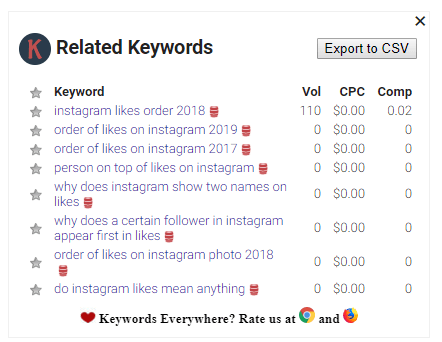
You can also find keywords simply by auditing competitor sites that rank for the search queries you’re targeting. Check out what they write about, their titles, headers, URLs, and anything else on their page that helps you focus your own keywords.
3. Writing Long-Form Content
Now that you have your topic and keywords, it’s time to get writing. Outline your post based on title, headers, and subheaders (all of which should utilize the keywords and questions you found) and start fleshing out your content.
Long-form content is simply that: long. Digital marketers have found success writing longer pieces of content compared to shorter content with the same topic and keyword optimization. The length of long-form content is heavily debated, and there isn’t one set word count that makes a piece long-form. My strategy has been to audit the top performing posts for the keyword I’m targeting and aim to write 20% more than the average word count.
Writing more helps you include more keywords, answer more questions, and seems to be favored by Google when it comes to ranking. Your content should also be well-written, proofread, and provide correct information, of course. If you can manage a longer post, you’ll likely find more success.
4. Linking and Creating Structured Silos
Website structure is important to the SEO of your site. This relates to content when it comes to creating structured silos. SEO siloing is the practice of organizing your website’s content into categories and subcategories. Search engines like Google can better recognize the topics and subtopics of a website if it is organized in a way that makes sense.
When you’re publishing content, consider the main categories and subcategories that posts fall into. If there is an important, highly searched keyword that you want to rank for, you’ll want to build structure for that post. The main post should be long-form, and there should be supporting posts that fall underneath it. All of these should link to one another to share link juice.
An example of this practice on Social Buddy is the hashtag post and supporting posts. The word “hashtags” is searched over 1 million times per month, and is an extremely broad term. Since Social Buddy shares social media information and advice however, this is a term that is highly relevant for the site.
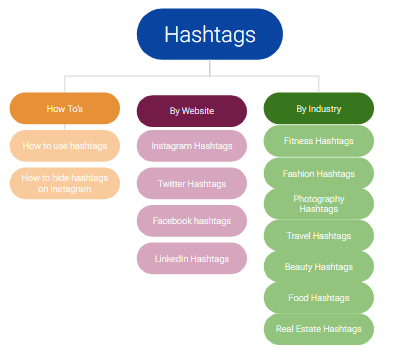
Instead of trying (and likely failing) to rank for simply “hashtags,” we wrote a series of posts with information on the best hashtags by industry and how to use hashtags across different social networking platforms. All of these posts linked up to a main post all about hashtags, and many link to one another as well.
Creating these supporting posts for a main topic helps Google recognize the relevance of that topic for your website, and it allows you to target the easier topics below the bigger keyword. Linking to other posts within your silo, and on your website in general, allows for visitors to click through, stay on your website for longer, and allows search engine crawlers to re-crawl your pages, sharing link juice.
This concept may seem complicated, but the bottom line is this: creating smaller, supporting posts for your larger targets with logically structured silos will help your website rank better. Linking between those posts shares traffic and link juice and can also improve the performance and ranking of your content.
5. Tracking and Auditing Your Content
You’ve researched, written, and optimized your content for SEO purposes through keyword placement, linking, and silo structuring: now you’re waiting for results. Content is effective in driving traffic, but it won’t happen overnight. It takes time for Google to recognize your website as trustworthy and authoritative on the topic you’re writing about.
Use Google Analytics or any other tool of your choosing to track your content’s progress. It may not rank at all right away – just keep at it. At first, Social Buddy did not see a huge difference, but churning out relevant, quality content over time gave the website more credibility – you can see how the page views increased slowly at first, then quickly as more posts began ranking higher.
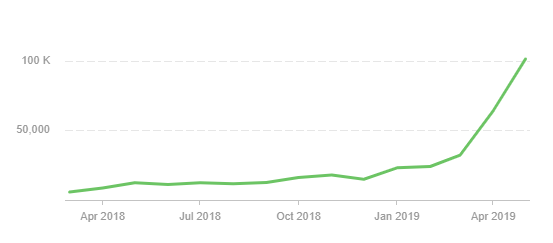
If you’ve waited and continuously published quality content with no results, consider auditing your content. We audit Social Buddy’s content at the beginning of each month, looking at what’s ranking well, what isn’t, and how we can replicate our successes and adjust the posts that aren’t so successful.
Because Social Buddy has been so successful through content, I tend to audit posts that were performing and then dropped, or posts that made it to search engine results on page 2 or 3, but need an extra kick to get to page 1. These posts are helpful to audit because Google already recognizes them as decent, so it often doesn’t take much to push them to page 1 so that they started getting more traffic.
When we audit posts for Social Buddy, we compare them against those that are ranking higher for our targeted keywords. We look at competitors titles, headers, meta descriptions, URLs, and more to see what they did differently. We also consider the searcher’s intent again to ensure that our post matches up, and check out KPI’s like bounce rate and click through rate to see if our post needs to better grab the reader’s attention.
Auditing can help you see where you went right and wrong – auditing a well-performing post gives you ideas on what you can replicate to improve upon poor performing posts. Checking back on your content is vital, and making minor edits can drastically improve rankings.
Drive Traffic To Your Website with Content
Content clearly works – it’s driven Social Buddy traffic from less than 10,000 monthly visitors to over 100,000 in only 5 months. This isn’t an isolated incident, however: content can work for a wide variety of websites if you find the right topics and keywords and work to publish helpful, relevant posts. Our content strategy is based on our knowledge of SEO and digital marketing and has brought amazing results.
If you need help with SEO, digital marketing, or content, contact SEO Digital Group. We provide SEO services, website design and landing page creation, content marketing, keyword research, and more.



Sorry, the comment form is closed at this time.